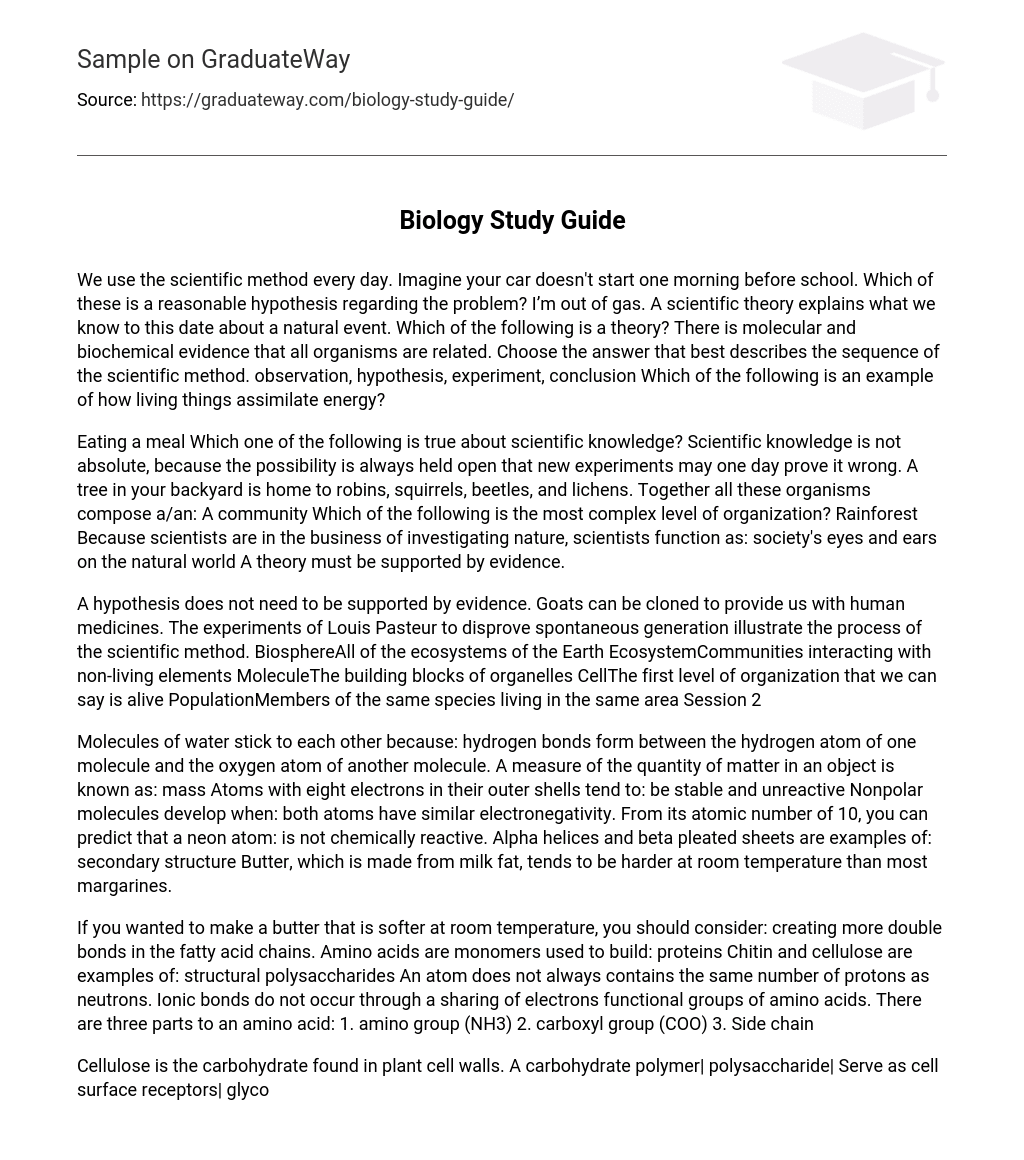We utilize the scientific method in our daily lives. Let’s say your car fails to start one morning before school. Which of these hypotheses is a reasonable explanation for the problem? Perhaps I am out of gas. A scientific theory serves to explain our current understanding of a natural occurrence. Which of the options below can be considered a theory? It is supported by molecular and biochemical evidence that all organisms are interconnected. Please select the answer that accurately details the steps in the scientific method: observation, hypothesis, experiment, conclusion. Which of the following demonstrates how living organisms absorb energy?
Eating a meal Which one of the following is true about scientific knowledge? Scientific knowledge is not absolute, because the possibility is always held open that new experiments may one day prove it wrong. A tree in your backyard is home to robins, squirrels, beetles, and lichens. Together all these organisms compose a/an: A community Which of the following is the most complex level of organization? Rainforest Because scientists are in the business of investigating nature, scientists function as: society’s eyes and ears on the natural world A theory must be supported by evidence.
In the realm of human medicine, it is possible to clone goats without needing any evidence to support this hypothesis. The scientific method was exemplified by Louis Pasteur’s experiments that disproved the concept of spontaneous generation. The biosphere encompasses all ecosystems on Earth, where interactions occur between communities and non-living elements. Organelles are formed by molecules, which in turn make up cells – the fundamental unit of living organization. In a specific area, a population comprises individuals belonging to the same species. Session 2.
Water molecules are held together by hydrogen bonds between the hydrogen and oxygen atoms. Mass measures the amount of matter in an object. Atoms with eight electrons in their outer shells are stable and unreactive. Nonpolar molecules form when atoms have similar electronegativity levels. A neon atom, with an atomic number of 10, does not undergo chemical reactions. Secondary structures include alpha helices and beta pleated sheets. Butter, made from milk fat, is typically harder at room temperature than most margarines.
If you want a butter that is easier to mold at room temperature, you can increase the amount of double bonds in the fatty acid chains. Proteins are composed of amino acids as building blocks. Examples of structural polysaccharides include chitin and cellulose. Atoms do not need to have an equal number of protons and neutrons. Ionic bonds form through functional groups of amino acids instead of electron sharing. Amino acids consist of three parts: 1. amino group (NH3) 2. carboxyl group (COO) 3. Side chain.
Cellulose, a carbohydrate polymer, can be found in plant cell walls. Glycoproteins act as receptors on the surface of cells while lipoproteins transport fats throughout the body. Structural proteins are present in hair and cartilage, and DNA serves as the primary molecule carrying life information. The Golgi complex modifies, stores, and transports proteins whereas ribosomes function as sites for protein synthesis. Rough endoplasmic reticulum is composed of a network of membranes with embedded ribosomes. Lastly, mitochondria serve as the “power plants” of cells.
The lipid synthesis takes place in the smooth endoplasmic reticulum, which is also responsible for maintaining the fluidity of the plasma membrane by incorporating cholesterol. Glucose receptors bind with insulin molecules to trigger cellular responses and facilitate glucose uptake. When a substance moves along its concentration gradient, it undergoes diffusion. The plasma membrane’s diverse capabilities are enabled by the proteins it contains. Cellular movement relies on the cytoskeleton, which acts as an internal scaffolding structure.
Plasmodesmata enable communication between plant cells. Animal cells require oxygen for ATP production. Cell walls are present in plants, bacteria, fungi, and protists. Cells contain organelles, which are structured entities performing specific functions. Chloroplasts exist in plant cells but not animal cells. The presence of a chemical signal determines protein production on free or endoplasmic reticulum-bound ribosomes. Simple diffusion involves molecules moving along their concentration gradient without transport proteins. Facilitated diffusion employs transport proteins to aid material movement down the concentration gradient.
Passive transport is the transfer of materials across a cell membrane without energy requirement. Active transport necessitates energy expense to move ions or molecules across a cell membrane. Endocytosis uses transport vesicles to bring large materials into the cell, while exocytosis employs transport vesicles to release materials externally from the cell.
Carbohydrate chains function as binding sites for numerous signaling molecules.
The fourth session discusses the close proximity of ectoplasm to the plasma membrane of a cell.





